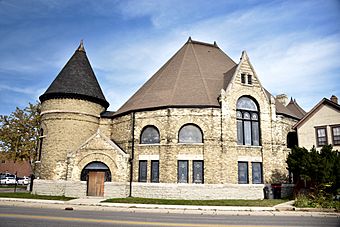First Universalist Church (Elgin, Illinois) facts for kids
Quick facts for kids |
|
|
First Universalist Church
|
|
|
U.S. Historic district
Contributing property |
|
 |
|
| Location | 55 Villa St., Elgin, Illinois |
|---|---|
| Area | 0.3 acres (0.12 ha) |
| Built | 1892 |
| Architect | Hunter, George |
| Architectural style | Romanesque, Richardsonian Romanesque |
| Part of | Elgin Historic District (ID83000318) |
| NRHP reference No. | 80001374 |
| Added to NRHP | November 7, 1980 |
The First Universalist Church in Elgin, Illinois is a very special building. It was built in 1892 and looks like a giant pocket watch! A talented architect named George Hunter designed it. This church is so important that it was added to the National Register of Historic Places in 1980. It is also part of the Elgin Historic District, which helps protect many old and important buildings in the city.
Contents
A Church with a Watchy Past
The Universalists in Elgin started their first church way back in 1866. It was called Unity Hall. This building was on the same spot where the current church stands today. In that same year, the National Watch Company factory was also finished. The church and the watch factory have always been connected.
The Watch Factory Connection
Silvanus Wilcox, a member of the church, was one of four Elgin citizens who gave land for the factory. The National Watch Company became the biggest employer in Elgin. It made over 4,000 watches every day!
By 1890, the church group had grown a lot. They needed a bigger building. They asked George Hunter, a church member, to design the new church. Hunter was one of the "Seven Stars" who came from the east to help start the watch factory.
A Church Shaped Like a Watch
George Hunter had a clever idea. He thought the new church should look like a pocket watch! The main part of the church was like the watch case. The roof was like the cover. The choir area was like the hinge. And the tall tower was like the snap. The pulpit, where the speaker stands, was placed where the number 12 would be on a watch face.
Wealthy people from the watch factory helped pay for the church. This meant they could afford really nice things inside. For example, the church has a special pipe organ made in Massachusetts. It has fourteen sets of pipes and is one of only ten like it ever built.
A Community Hub
The church became a very important place for the community. The Universalists often let new religious groups use their building. This was until those groups could find their own permanent homes. The church also hosted many community and cultural events.
The Elgin National Watch Company factory was taken down in 1966. Today, there are not many buildings left that remind people of the factory. The Elgin National Watch Company Observatory is one of the few. The watch-shaped First Universalist Church is a great reminder of Elgin's busy past. Because of its history, the church was added to the National Register of Historic Places on November 7, 1980. It was also included in the Elgin Historic District on May 9, 1983.
Music in the Church
In September 1997, a Christian music artist named Rich Mullins and his band, the Kid Brothers of St. Frank, used the church to practice. They were getting ready for Mullins' fall tour. On September 10, Mullins recorded some demo songs there. These songs were later released as part of his album The Jesus Record.
Church Design and Features
The church is a two-story building made of stone. It was built to look like a pocket watch. You can find it on a triangular piece of land where Villa and Dupage Streets meet. The building's design is strongly influenced by the Richardsonian Romanesque style. This style often uses heavy stone and round arches.
Unique Architectural Details
The main part of the church has sixteen sides and a roof that looks like a tent. There is also a tower with a pointy, cone-shaped roof. This tower is as tall as the main part of the church. The tower connects to the main building with entrances on both sides. These entrances have small gabled roofs.
The church has a stone base that is about 4 feet tall. Eight sections of the building have tall, wide arch windows. These windows are the original stained glass designs, which are very beautiful.



